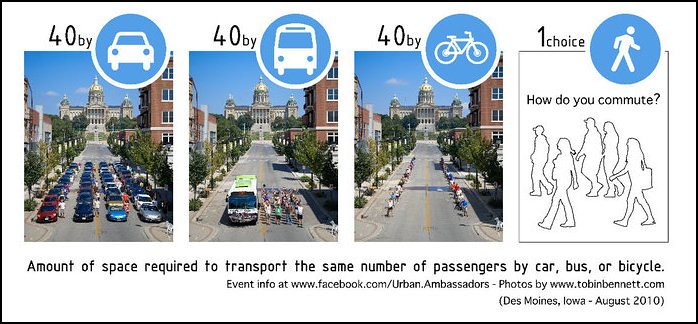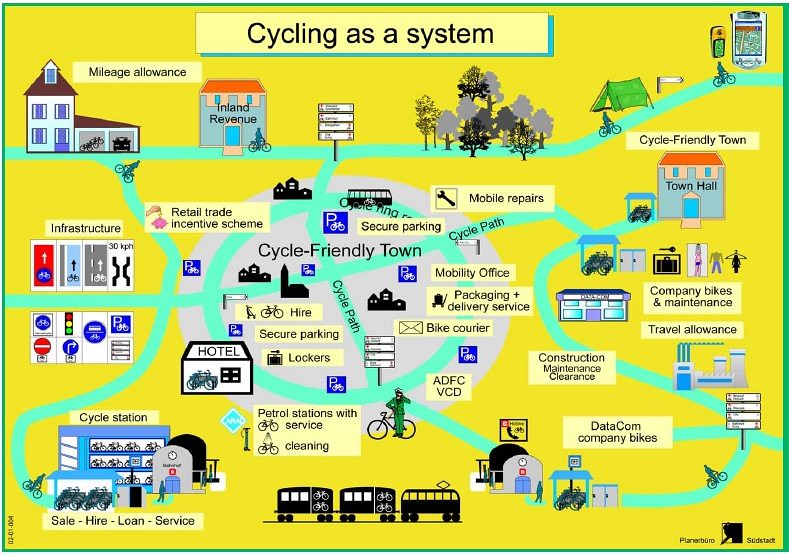Transport Politic's definitive piece on the Republican and Democratic Party Platforms positions on infrastructure
Last week, I wrote a very short piece on the Republican Party Platform on city-related issues ("A missed opportunity to focus on the Republican urban agenda at the Republican National Convention") focusing on what could a Republican urban agenda look like, recognizing that Republican representation at the federal and state level tends to skew rural and exurban.
I haven't yet looked at the Democratic Party Platform or the position statement on infrastructure of the Democratic Nominee, Hillary Clinton.
Transport Politic has gone through and compared both platforms, created a handy table, etc. The entry, "Both parties claim support for investing in infrastructure. But how will they do it?" needs to be read widely.
Thank you, Yonah Freemark!
Summary of the respective positions -- from Transport Politic
| Democratic Party and Hillary Clinton | Republican Party and Donald Trump | |
| Federal role in transportation | Expand to emphasize multimodalism; encourage connections between transportation, cities, climate, and social equity | Reduce to only encompass highways (GOP); or fund all types of transportation (Trump) |
| Funding for transportation | Roughly double overall spending using business tax reform, create infrastructure bank | Do not adjust funding to inflation (GOP); or expand massively through unknown means (Trump) |
| Transit and intercity rail | Increase support to build social equity and combat climate change | Eliminate federal role (GOP); or improve (Trump) |
| Non-motorized modes | Improve funding for biking and walking projects | Eliminate federal role |
| Climate change | Orient transportation investments toward responding to climate change | Do nothing to address climate change; invest in coal |
| Project management | Support union requirements | Eliminate union requirements |
The need for national transportation mode plans. One of the things that hurts is not having federal or national transportation plans that Congress acknowledges.
Although for the most part, Congress accepts and lauds the National Highway System comprised of the Interstate Highway System and other road networks.
But they won't adequately fund the system, which is now mostly reaching the end of its useful life and needs money for rehabilitation and improvement.
But other modes often don't have plans, including shipping and ports, biking, transit, and walking. Of course, even if we had plans, would Congress care?

National Rail Plan. For example, Congress passed legislation, the Passenger Rail Investment and Improvement Act of 2008 (PRIIA), requiring the creation of a National Rail Plan, complemented by plans created by each state. (States that pass rail plans can then create regional plans crossing state boundaries.)
But even though there is a National Rail Plan, the Republican-controlled Congress tends to be anti-Amtrak and anti-National High Speed Rail, but pro-privatization, even though most observers consider Britain's rail privatization -- the most significant example of such a program -- to be highly problematic and one that has experienced many setbacks
With regard to the capacity of Interstate freeways, diverting freight movement from trucks to freight rail can add significantly to throughput.
Biking (and pedestrian) planning. Other countries demonstrate that in urban areas, bicycling can comprise a significant proportion of daily trips, albeit mostly in cities.
I have a piece discussing "What should a US national bike strategy plan look like?" which outlines setting goals for sustainable mode splits for biking that are much higher than the current national average. But for the most part, Republicans in Congress--even if they bike themselves--deride biking as an activity for children, not as a serious transportation mode.
Other countries, such as Germany, the Netherlands, Denmark, and the UK, have national cycling plans. The UK, with low rates for trips by cycling--like the US--sets a goal for a doubling of trips by bike by 2025.

Bicycle Traffic as a system, diagram, German National Bicycle Plan, 2002-2012
The organizing principles for such a plan:
1. Urban Form and how it shapes transportation choices. Include section discussing urban form based on the concepts of Peter Muller (Walking City, Transit City, Recreational Auto Era, Metropolitan City) and how it shapes transportation choices, how we got to where we are today, etc.
2. Transportation Physics and Mobility Throughput. This is pretty basic, that you can move more people by walking or transit or biking in the same amount of space used by cars.
3. Other policies that shape mobility choices and current practice. There was a great piece, "The Petro States of America," in Businessweek about how the US is a major petroleum production nation (that should be obvious) and how that shapes economic and other national policy in multiple ways that support oil production and consumption.
4. Bicycles as toys/bicycles for recreation vs. bicycling for transportation.
5. Creating social and behavioral change through structural-systemic change, social marketing and other processes. Consider how this article, "Gentle Nudges Work to Get People Exercising" (Wall Street Journal) discusses the adoption of positive health behaviors as routine practices and apply it to sustainable transportation practices.
6. Differentiating sustainable transportation policy and practice according to spatial form, specifically whether the predominate land form is urban, suburban, or rural. My piece "Ideas for making bicycling irresistible in Washington DC" discusses this with regard to the urban setting, and the work I did in Baltimore County focuses on suburban oriented practices ("Best practice bicycle planning for suburban settings using the action planning method").
Transit planning. Similarly, instead of deriding transit as being widely used only in six cities (as Yonah points out, they are incorrect, as the top 10 most populous cities comprise 47% of the base of transit users), transit's effectiveness where it works superlatively should be celebrated!
Because transit is so much more efficient in moving significant numbers of people, Congress needs to learn and acknowledge the factors that lead to success. Instead, like with the recent hearing on WMATA--the transit system in the DC area--and its safety failures, the House Republicans take the opportunity to denigrate transit whenever they can.
Because transit is so expensive to build and fund, and because metropolitan areas are the most significant economic units and producers in the national economy, there is a justifiable federal role in transit funding and planning.
Ports and shipping. It's incredible to me that we don't have a national ports planning process. Because of the expansion of the width of the Panama Canal, ports across the country are expanding. But there isn't enough business to go around.
Tough choices should have been made to limit wasted investment ("Panama Canal expansion exposes US infrastructure, shipper woes," Business Insider; "The Post-Panamax Effect: How the Panama Canal Expansion is Reshaping America’s Ports," CBRE; "East and West Coast Ports To Battle for U.S. Region After Panama Canal Expansion," C.H. Robinson).
Airports. I don't know much about airport planning. I know that there are negatives about the push by Congress to privatize the air traffic control system ("Shuster wants to turn air traffic control over to a nonprofit," Pittsburgh Post-Gazette; "Privatizing air traffic control will increase traveler costs," USA Today).
But there are many flaws in the way the airport system works, especially in the limitations on the use of airport-derived funds to fund transit connections that also benefit non-airport users. Similarly, shorter distance airport trips, such as between DC and NYC, would be best shifted to faster rail, were the US to have a high speed rail system.
A framework for national transportation planning. I define regional as either multi-state and as two or more metropolitan areas. I delineate transit networks from this blog entry "Second iteration, idealized national network for high speed railpassenger service"
-------
this is based on thinking about transportation networks in five overarching dimensions:
1. International -- connections between countries. (The map above shows a couple connections between the U.S. and Canada, and one connection from San Antonio to Monterrey, Mexico through Laredo.)
2. National -- anchors of a national transportation system, current anchors are the Interstate Highway system, the freight railroad system, and airplane travel. We do not have a robust national passenger railroad network presently, although Amtrak complemented by state support, has a number of heavily used corridors. Commuter systems operate separate from Amtrak, and don't benefit from its preferred access to freight railroads.
3. Regional -- multi-state connections -- for the most part these don't exist for transit, but do for freight railroad, airplane travel, and the Interstate highway system. The Northeast Corridor railroad passenger service offered by Amtrak is an example of such a transit network. Inter-state bus services operate more on a regional footprint.
4. Metropolitan -- transit systems like the WMATA subway and bus system, the combined railroad, subway, bus, and waterborne transit services in the NYC or Boston regions.
5. Sub-metropolitan transit systems (in the DC region, locally provided services such as RideOn in Montgomery County Maryland or the Downtown Circulator in DC are examples of services within the subnetwork category of the Metropolitan Transit Network).
Labels: elections and campaigns, federal policies and the city, gasoline excise taxes, public finance and spending, transportation infrastructure, transportation planning






2 Comments:
Tim Kaine speaks at the National Urban League conference.
http://www.bizjournals.com/baltimore/news/2016/08/04/tim-kaine-hillary-and-i-are-committed-to-working.html
even worse than the abandonment of passenger rail in the US is the abandonment of waterways and the usage of them for moving people- right here in DC we once used our waterways and they were in a huge manner responsible for the initial location and prosperity of the city- this is entirely lost on most people who do not realize the extent upon which DC once had ships going to and from the city. We waste incredible resources in this country that others would die for in other places.
Post a Comment
<< Home